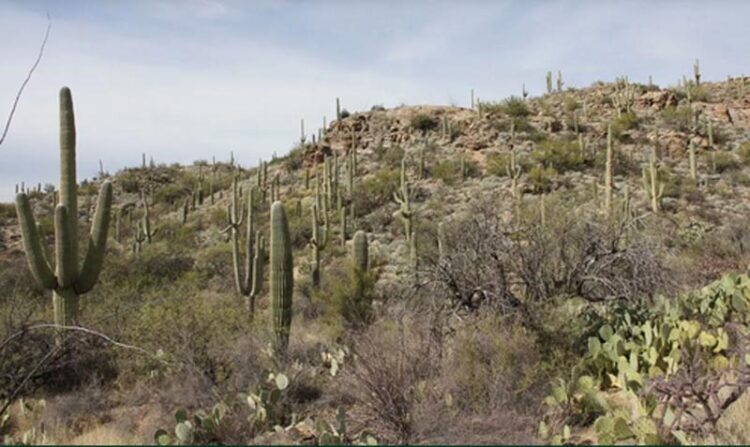New method for assessing climate change risks to ecosystems

Deserts like the one in Saguaro National Park continue to spread due to climate change.
(c) Timo Conradi / Universität Bayreuth
The Bayreuth plant ecologists Prof Dr Steven Higgins and Dr Timo Conradi argue in favour of interpreting the coming climatic changes from the perspective of plants in order to better assess the risks of climate change for ecosystems. If information on the physiological reactions of plant species to changing temperatures, soil water content and atmospheric CO2 concentrations is taken into account, the consequences of climate change for ecosystems can be better predicted. They report this in a recent article in the scientific journal “Nature Ecology & Evolution”.
Predicting the risks to species and ecosystems from climate change is necessary to develop strategies for adapting conservation practices A common approach to risk assessment quantifies how much the climate will change in an area. The results then read, for example: “Region A will be exposed to greater climatic changes than other regions, so the climate change risk for the ecosystems in region A is particularly high.” “However, it is unlikely that the climate change risk will be correctly assessed using this method,” says Dr Timo Conradi, a member of staff at the Chair of Plant Ecology at the University of Bayreuth and lead author of the recently published study. “If it does not also take into account how the growth of plants reacts to climate change, this method may identify incorrect risk areas.” For example, an additional degree of warming in hot tropical climates can have a negative effect on plant growth, while it tends to promote growth in cold tundra climates. “The physiological reactions of plants to climatic changes should therefore be taken into account in the risk assessment,” adds Conradi.
The Bayreuth researchers have now combined physiological growth models of over 135,000 vascular plant species and information on the growth form of these species with climate data. This has made it possible to describe the suitability of current and future climates for the various plant growth forms that characterise the Earth’s ecosystems, such as deciduous trees, conifers, grasses and succulents. The Bayreuth researchers have labelled this description of the climate from the perspective of plant growth forms the “phytoclimate”. On this basis, the researchers predict that, depending on the extent of future greenhouse gas emissions, between 33% and 68% of the global land surface will experience a significant change in the phytoclimate, i.e. the way in which the climate influences the formation of ecosystems, by 2070. The Bayreuth plant ecologists also predict that phytoclimates will develop on 0.3 to 2.2% of the land surface that do not exist today, and that 0.1 to 1.3% of the currently existing phytoclimates will disappear. The model projections also show where the greatest climatic changes will occur by the end of the century from a plant-physiological perspective, which of the phytoclimates existing on Earth today will no longer exist in the future, and where new climates will emerge from a plant-physiological perspective.
“The geographical pattern of change, disappearance and novelty of phytoclimates differs significantly from the patterns of climate trends identified in previous studies,” reports Conradi. The consequence of this must be a reorientation of nature conservation strategies, particularly in the regions that the study has identified as new high-risk regions, in order to positively shape ecological change there. “Our results indicate that a profound change in the biosphere and a significant shift in the Earth’s vegetation zones is underway, and they emphasise the need for timely adaptation of biodiversity conservation strategies. However, our results also show that negative ecological consequences can be significantly mitigated by reducing greenhouse gases.”
This research was funded by the German Federal Ministry of Education and Research.
Wissenschaftliche Ansprechpartner:
Dr. Timo Conradi
Academic Councillor, Chair of Plant Ecology
Tel.: +49 (0) 921 55-2805
Mail: timo.conradi@uni-bayreuth.de
Originalpublikation:
Timo Conradi, Urs Eggli, Holger Kreft, Andreas H. Schweiger, Patrick Weigelt & Steven I. Higgins (2024): Reassessment of the risks of climate change for terrestrial ecosystems, Nature Ecology & Evolution, https://doi.org/10.1038/s41559-024-02333-8
Media Contact
All latest news from the category: Ecology, The Environment and Conservation
This complex theme deals primarily with interactions between organisms and the environmental factors that impact them, but to a greater extent between individual inanimate environmental factors.
innovations-report offers informative reports and articles on topics such as climate protection, landscape conservation, ecological systems, wildlife and nature parks and ecosystem efficiency and balance.
Newest articles

NASA: Mystery of life’s handedness deepens
The mystery of why life uses molecules with specific orientations has deepened with a NASA-funded discovery that RNA — a key molecule thought to have potentially held the instructions for…

What are the effects of historic lithium mining on water quality?
Study reveals low levels of common contaminants but high levels of other elements in waters associated with an abandoned lithium mine. Lithium ore and mining waste from a historic lithium…

Quantum-inspired design boosts efficiency of heat-to-electricity conversion
Rice engineers take unconventional route to improving thermophotovoltaic systems. Researchers at Rice University have found a new way to improve a key element of thermophotovoltaic (TPV) systems, which convert heat…



